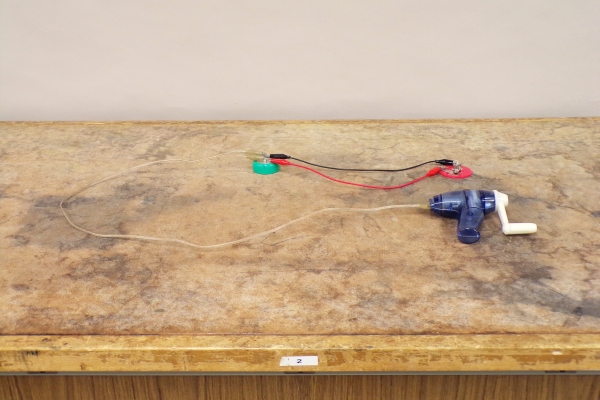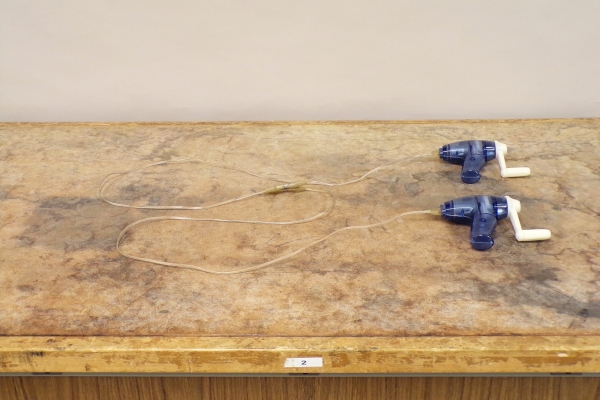
The hand generator, a capacitor and a light bulb are connected in parallel. When you crank the hand generator, you charge the capacitor and the bulb slowly begins to light. When you disconnect the generator, the bulb remains lit, and it becomes dimmer and dimmer as the capacitor discharges through it.

Two hand generators are connected together. When you crank one generator, this causes the handle on the other generator to turn (in the same direction, if the terminals on one generator are connected to the same ones on the other generator; in the opposite direction if each terminal goes to the opposite one on the other generator).
The pages for demonstrations 52.36 -- Falling weight generator, and demonstration 72.12 -- AC/DC generator, describe in detail how generators convert mechanical energy (or work) into electrical energy (or work). Each hand-cranked generator in this demonstration has inside it a small permanent-magnet D.C. motor. On the shaft of the motor is a small gear, which is connected to the crank via a gear reduction, so that when you turn the crank, the motor shaft turns significantly faster. (The gear ratio is 48.75:1.) When you turn the crank, this turns the shaft of the motor, which turns the armature coils inside the field of a set of permanent magnets. The changing magnetic flux through the coils as they turn, induces an EMF in them, which, if a load is connected across the coils, causes a current to flow through them and the load. As is printed on a sticker near the crank, if you hold the generator upright, when you turn the handle in the clockwise direction, the top socket of the output jack is positive, and when you turn the handle counterclockwise, the bottom socket is positive. One side of the cable is copper, and the other side is tinned copper, and the insulation is transparent so that you can see which conductor is which. You can thus see which part of the circuit is connected to the top socket, and which is connected to the bottom, and know in which direction you are sending current through the circuit according to the direction in which you turn the handle. Important: Please observe the polarity when you are charging the capacitor, which is polarized. The negative terminal is the one near the black stripes on the green outer sleeve of the capacitor.
With these hand-cranked generators (Genecon), you can produce currents as high as about 200 mA at about six volts, or a power of about 1.2 watts. The lamp is a #50 (7.5 V, 0.22 A). The capactor is an NEC/Tokin 1.0-F (yes, 1 farad!) capacitor with a working voltage of 5 V. The capacitor is a special type called an electric double layer capacitor, or EDLC, which is a type of supercapacitor. Whereas normal capacitors consist of two electrodes separated by a dielectric, in which charging the capacitor results in polarization of the dielectric, EDLCs have between the electrodes an electrolyte solution. When one charges the EDLC, the ions in the electrolyte are drawn to their respective electrodes. The electrodes are typically made of a porous material, which provides much greater surface area than do the electrodes in a normal capacitor, and thus results in very high capacitance. You can find descriptions of such devices here or here, for example.
You can connect one of the generators to the light bulb only, and use it to light the bulb, or you can connect the capacitor in parallel with the light bulb. In the latter case, when you start turning the generator, you begin to charge the capacitor, and the bulb does not immediately light. As you keep charging the capacitor, the current that flows to it decreases, and increasingly greater current flows through the lamp, which becomes brighter and brighter as you turn the crank. Once you have fully charged the capacitor (the lamp is at maximum brightness), if you let go of the handle, the crank keeps turning (in the same direction; vide infra), and the light bulb remains lit. As the capacitor discharges through the generator and the lamp, the generator slows down and the lamp grows dimmer. Alternatively, once you have fully charged the capacitor, you can disconnect the generator. The bulb continues to glow, and it gets dimmer and dimmer as the capacitor discharges.
You can also connect the two generators together, either each with its terminals connected to the same terminals on the other, or with the terminals of one connected to the opposite terminals on the other. If you connect the same terminals together, then when you turn the crank on one generator, the crank on the other generator turns in the same direction. If you connect opposite terminals together, then the crank on the second generator turns in the opposite direction to that in which you turn the crank on the first generator. This happens because the current induced in the armature coils of the generator obeys Lenz’s law (see Demonstration 72.09 -- Lenz’s law). We can understand this if we imagine a coil toward which we move the north end of a magnet. Say that the ends of the coil are labeled 1 and 2, and that the coil is wound clockwise from terminal 1 to terminal 2 as we view it from the side toward which we will bring the magnet. As we bring the north end of the magnet toward the coil, this increases the magnetic flux through the coil. The induced current, then, must produce an opposite change in flux. The right-hand rule tells us that the current must flow in the counterclockwise direction – from terminal 2 to terminal 1. If we place a meter between the terminals of the coil, then, we find that terminal 1 is positive, and terminal 2 is negative. If the coil were connected to a capacitor instead of a meter, once we stopped changing the magnetic flux, the current in the coil would reverse as the capacitor discharged through it. The current would flow clockwise, from terminal 1 to terminal 2. This would produce magnetic flux in the same direction as the initial change that we made by bringing the north pole of the magnet toward the coil. If we now brought the north end of the magnet toward the coil, it would be pulled toward the coil. Thus, we should expect that when you charge the capacitor with the generator and then let go of the handle, the crank keeps turning in the same direction, which is what happens. Similarly, when you connect the two generators so that the same terminals are connected together, the current flowing out of (or into) the top jack of the generator whose crank you are turning, flows into (or out of) the top jack on the second generator, which causes the crank on the second generator to turn in the same direction in which you are turning the crank on the first generator. If, of course, you connect opposite terminals together, the current now flows in the same direction through both generators, and the crank on the second generator turns in the opposite direction to that in which you turn the crank on the first generator.